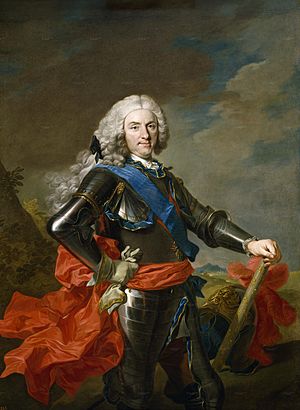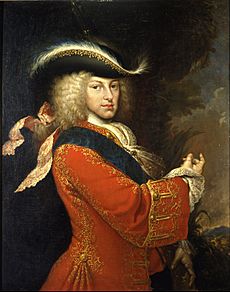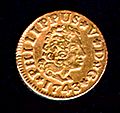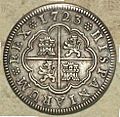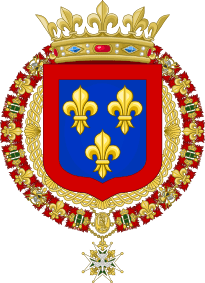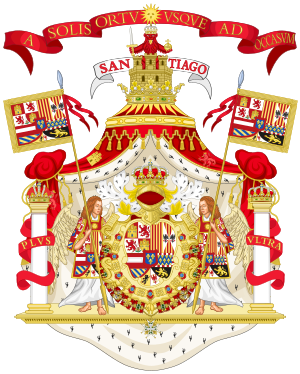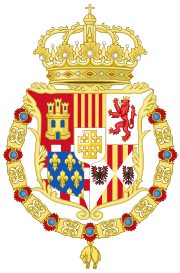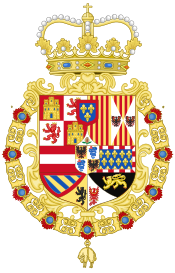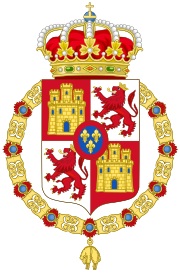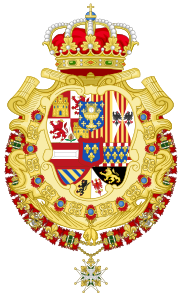Philip V of Spain facts for kids
Philip V (born 19 December 1683 – died 9 July 1746) was the King of Spain. He ruled from 1700 to 1724, and then again from 1724 until his death in 1746. His total time as king was 45 years. This makes him the longest-reigning monarch in Spanish history.
Philip made many important changes in Spain. He made the king's power stronger and reduced special rights for different regions. He also reorganized how the Spanish Empire was run.
Philip was born into the French royal family. He was the grandson of King Louis XIV. Philip was not expected to become a king. But his great-uncle, Charles II of Spain, had no children. Charles II named Philip as his heir in his will.
Philip became the first king from the House of Bourbon to rule Spain in 1700. Other European countries worried that France and Spain would become too powerful together. This led to the War of the Spanish Succession, which lasted 13 years. The war ended with the Treaty of Utrecht. This treaty said that France and Spain could never be ruled by the same person. It also meant Spain lost some lands, like the Spanish Netherlands and parts of Italy.
In 1724, Philip gave up his throne to his oldest son, Louis. But Louis died later that year. So, Philip had to become king again. Philip struggled with depression. His wife, Elisabeth Farnese, often managed the government. When Philip died in 1746, his son Ferdinand VI became king.
Contents
Early Life and Family
Birth and Childhood
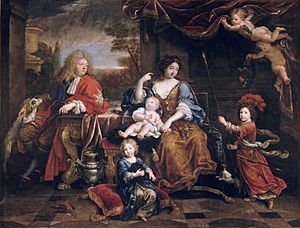
Philip was born on 19 December 1683 at the Palace of Versailles in France. He was the second son of Louis, Grand Dauphin. His mother was Maria Anna Victoria of Bavaria. His father was the oldest son of Louis XIV of France.
Philip was the younger brother of Louis, Duke of Burgundy. At birth, Philip was given the title Duke of Anjou. This was a common title for younger sons in the French royal family. He was known by this name until he became King of Spain.
It was not expected that Philip would ever rule France. His older brother was second in line to the French throne.
Education and Learning
Philip and his brothers were taught by François Fénelon, who was an Archbishop. They also learned from Paul de Beauvilliers.
Becoming King of Spain
In 1700, Charles II of Spain died. He was the last king from the Habsburg family to rule Spain. He had no children. His will named Philip as the next king. Philip was the grandson of Charles's half-sister.
Philip had a strong claim to the Spanish throne. His Spanish grandmother and great-grandmother were older than the ancestors of another claimant, Archduke Charles of Austria. The Austrians argued that Philip's grandmother had given up her claim to the Spanish throne when she married. But the French said this was only if her dowry (money paid with the marriage) was paid, which it never was.
After a long meeting, the French Royal Council agreed that Philip would become king. But he had to promise that he and his children would never claim the French throne. The Spanish ambassador was then introduced to the new king.
First Marriage
On 2 November 1701, Philip married 13-year-old Maria Luisa of Savoy. His grandfather, King Louis XIV, chose her for him. She was the daughter of Victor Amadeus II, Duke of Savoy.
Maria Luisa became very popular as Queen of Spain. She even ruled Spain for her husband sometimes. She was only 14 when she ruled for nine months in 1702. This was while Philip was visiting his lands in Italy. Sadly, Maria Luisa died in 1714 at age 26 from tuberculosis. This was a very sad time for Philip.
War of the Spanish Succession
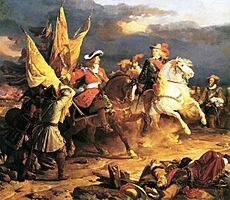
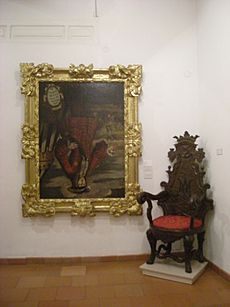
Other European countries worried about France and Spain being united under one king. In 1701, King Louis XIV of France made a rule. It said that if Philip's older brother died without an heir, Philip would give up the Spanish throne to become King of France. This made other countries even more worried.
Soon after, the War of the Spanish Succession began. Countries like England, the Netherlands, and Austria formed an alliance. They fought against France and Spain. They wanted to keep the balance of power in Europe.
In Spain, the region of Castile supported Philip. But most of the nobles in the Crown of Aragon supported Charles of Austria. Charles also claimed the Spanish throne.
The war was fought in Spain, Europe, and even North America. In North America, it was called Queen Anne's War. During the war, Philip made new laws called the Nueva Planta decrees. These laws made Spanish rule more centralized. They removed special rights from many independent kingdoms in Spain. Only the Kingdom of Navarre and the Basque region kept their special rights. This was because they had supported Philip in the war.
In 1712, Philip was offered the chance to give up the Spanish throne to become heir to France. But he refused.
The war ended with the Treaty of Utrecht. Philip was recognized as King of Spain. But Spain had to give up Menorca and Gibraltar to Great Britain. It also lost the Spanish Netherlands, Naples, Milan, and Sicily to Austria and Savoy. These losses made the Spanish Empire in Europe much smaller.
Philip tried to regain these lost lands. He fought in the War of the Quadruple Alliance (1718–1720). But Spain was forced to make peace again.
Second Marriage
After Queen Maria Luisa died in 1714, Philip decided to marry again. His second wife was Elisabeth of Parma. She was 22 years old when she married Philip, who was 31. The marriage was arranged by Cardinal Alberoni.
Giving Up the Throne (Abdication)
On 14 January 1724, Philip gave up his throne to his oldest son, Louis. Louis was 17 years old. Historians still discuss why Philip did this. Some think he was struggling with his mental health.
Another idea is that Philip hoped to become King of France. Many members of the French royal family had recently died. The Treaty of Utrecht said France and Spain could not be united. But Philip might have thought that if he was no longer King of Spain, he could become King of France.
However, Louis died on 31 August 1724 from smallpox. He had only been king for seven months and had no children. So, Philip had to return to the Spanish throne in 1724.
Later Years as King

Philip helped his Bourbon relatives gain land in other wars. Spain got back Naples and Sicily from Austria. They also took Oran from the Ottomans. Near the end of his rule, Spanish forces also defended their lands in America from a British invasion. This was during the War of Jenkins' Ear (1739–1748).
During Philip's reign, Spain started to recover. It had been struggling for a long time. The population grew, but the money system was old-fashioned. The government often spent more money than it had. The king had many people working in his palaces. But the army and government workers sometimes went months without pay. Silver from the New World helped keep the country going. In 1739, Spain stopped paying its debts.
Death
Philip suffered from periods of depression. His second wife, Elizabeth Farnese, had a lot of influence over him. She had more sons with him, including Charles III of Spain. From 1737, a singer named Farinelli helped ease Philip's mental illness. Farinelli would sing for the king and queen every night.
Philip died on 9 July 1746 in El Escorial, near Madrid. He was buried in his favorite place, the Royal Palace of La Granja de San Ildefonso. His son, Ferdinand VI of Spain, became the next king.
Philip's Legacy
Historians have mixed views on Philip V. Some say he didn't improve the government much. They also say he often favored France's interests over Spain's.
However, Philip did make some important changes. He made the central government stronger. He also made it more important for people to be good at their jobs. The economy improved during his reign. There was more production, and fewer famines. The government also supported industry, farming, and shipbuilding. The Spanish navy was rebuilt.

To remember what happened to the city of Xàtiva, its local museum displays a portrait of Philip V upside down. This is because he ordered the city to be burned in 1707.
The province of the New Philippines, which is now part of Texas in the United States, was named in Philip's honor in 1716.
Philip V also supported trade between Spain and its American lands. He helped important figures in naval history, like the corsair Amaro Pargo. Philip V often helped Amaro Pargo in his trading trips. He even made him a captain of a ship going to Caracas.
Issue
Philip married Maria Luisa of Savoy on 3 November 1701. They had 4 sons:
- Louis I of Spain (1707–1724) married Louise Élisabeth d'Orléans but had no children.
- Philip (1709–1709) died young.
- Infante Philip of Spain (1712–1719) died young.
- Ferdinand VI of Spain (1713–1759) married Barbara of Portugal but had no children.
Philip married Elisabeth Farnese on 24 December 1714. They had 6 children:
- Charles III of Spain (1716–1788) married Maria Amalia of Saxony and had children.
- Infanta Mariana Victoria of Spain (1718–1781) married King Joseph I of Portugal and had children.
- Infante Philip of Spain (1720–1765) became Duke of Parma and started the Bourbons of Parma family line. He married Louise Élisabeth of France and had children.
- Infanta Maria Teresa of Spain (1726–1746) married Louis of France, Dauphin of France and had children.
- Infante Louis of Spain (1727–1785) was known as the Cardinal Infante. He was an Archbishop of Toledo and a Cardinal. In 1754, he gave up his church titles and became Count of Chinchón. He married María Teresa de Vallabriga and had children, but they did not have royal titles.
- Infanta Maria Antonia of Spain (1729–1785) married Victor Amadeus III of Sardinia and had children.
| Family of Philip V in 1743 |
|---|
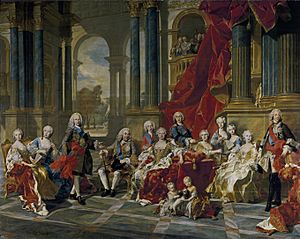
"The Family of Felipe V"; (L-R) Mariana Victoria, Princess of Brazil; Barbara, Princess of Asturias; Ferdinand, Prince of Asturias; King Philip V; Luis, Count of Chinchón; Elisabeth Farnese; Infante Philip; Louise Élisabeth of France; Infanta Maria Teresa; Infanta Maria Antonia; Maria Amalia, Queen of Naples and Sicily; Charles, King of Naples and Sicily. The two children in the foreground are Princess Maria Isabella Anne of Naples and Sicily and Infanta Isabella of Spain (daughter of the future Duke of Parma)
|
Coins
Heraldry
| Heraldry of Philip V of Spain | ||||||||||||||||||||
|---|---|---|---|---|---|---|---|---|---|---|---|---|---|---|---|---|---|---|---|---|
|
||||||||||||||||||||
See also
 In Spanish: Felipe V de España para niños
In Spanish: Felipe V de España para niños
- Nueva Planta decrees
- Royal Madrilenian Academy of Medicine


